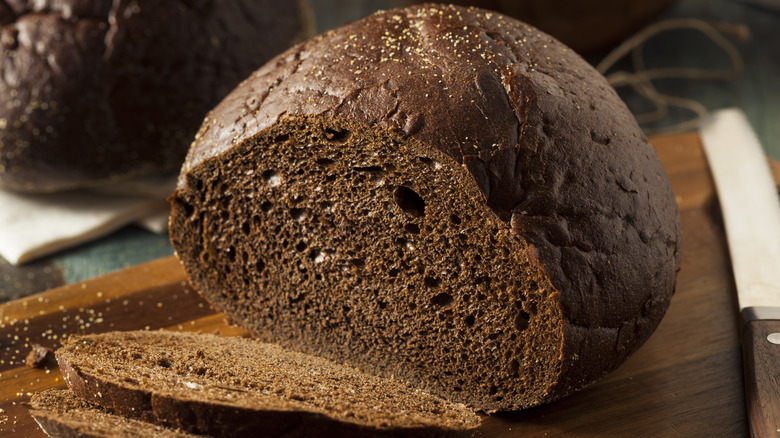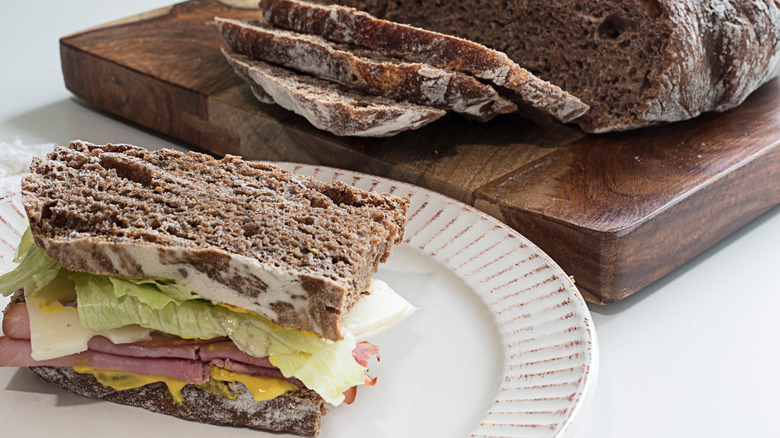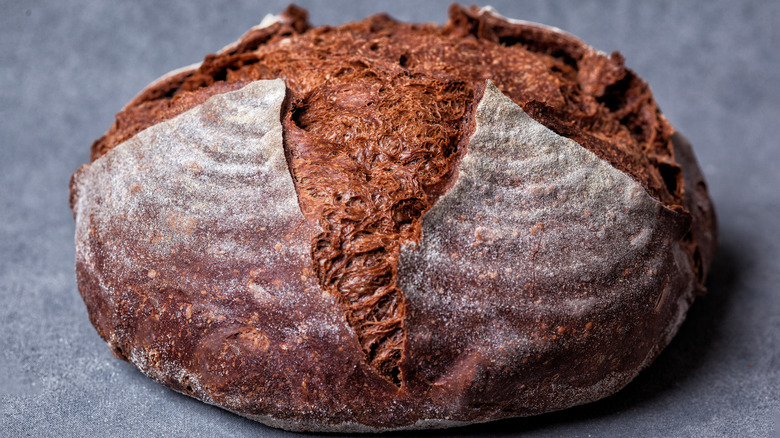How Pumpernickel Bread Gets Its Signature Color
Pumpernickel bread is easy to identify. If you're not a bread-head, then it can be difficult to tell the difference between white and brioche, for example, but pumpernickel is famously a deep brown color which you don't see in other breads. Why exactly is that?
There's a couple of different ways that pumpernickel bread turns brown: the traditional German way and the American way. The classic pumpernickel recipe involves slowly baking rye flour or rye berries at low temperatures for a long period of time, browning the bread as it cooks (something called the Maillard reaction). Originally, pumpernickel's long baking time is what cooked it to such a deep color.
That's not the case with the American version, which isn't cooked so long. Instead, lots of pumpernickel bread you might see today is artificially colored with molasses or cocoa powder. This roundabout way of giving pumpernickel its signature brown hue also has the side-effect of sweetening it. If you're in the United States, then the pumpernickel you're eating is very similar to regular rye bread.
The Maillard reaction and pumpernickel
The Maillard reaction is a term which comes up very frequently in food science, and it's the reason why lots and lots of foods take on a brown color: steak, beer, coffee, soy sauce, grilled vegetables, and pumpernickel bread. In short, it refers to chemical reactions between sugars and amino acids in the food when it's exposed to enough heat, which changes both the color and the flavor (it's scientifically where the roasted flavor of cooked foods comes from). It's often just referred to as browning foods, and you use it all the time when you're cooking.
Pumpernickel was originally made with coarse, ground-up rye berries (and so it's considered a kind of rye bread) which might be cooked for as long as 14 hours at a low 250 degrees Fahrenheit. This bread also has no crust because moisture is kept out. The end result is a robust bread that works great for tea sandwiches and other foods with strong flavors. If you're making pumpernickel the more modern way, it doesn't need to bake for as long because you'll be adding coloring agents to it yourself — you can make it this way in about an hour.
The German history of pumpernickel
Perhaps it won't surprise you to learn that the word pumpernickel comes from Germany. More specifically, pumpernickel bread comes from the region of Westphalia in Northwest Germany, and it dates back to at least 1738, when it was first mentioned in writing. As for the origins of the word, it may not be what you're expecting: "Nickel" is an old German slang term for "goblins" or "devils," and the German word "pumpern" can mean either thumping or flatulence. So, the word pumpernickel loosely translates to "the devil's fart," possibly a joke about how the bread is tough to digest.
Is pumpernickel actually so difficult to digest? Traditional it can be, just because of how dense it becomes after the baking process. Since rye flour is low in gluten, which is very helpful for making bread rise, it's possible to make homemade pumpernickel way too heavy if you accidentally overproof your bread. So long as you don't overdo it, kneading helps bread rise properly, so check the recipe for how much it requires. You don't want to end up like pumpernickel's namesake.


